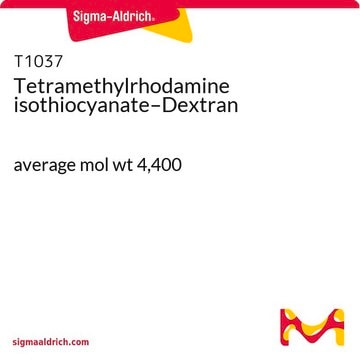283924
Rhodamine B isothiocyanate
mixed isomers
Synonim(y):
RBITC
About This Item
Polecane produkty
Postać
powder
kolor
purple to violet
red to red-brown
rozpuszczalność
methanol: 10 mg/mL
λmaks.
555 nm
Zastosowanie
diagnostic assay manufacturing
hematology
histology
temp. przechowywania
room temp
ciąg SMILES
[Cl-].CCN(CC)c1ccc2c(OC3=CC(\C=CC3=C2c4ccc(cc4C(O)=O)N=C=S)=[N+](\CC)CC)c1
InChI
1S/C29H29N3O3S.ClH/c1-5-31(6-2)20-10-13-23-26(16-20)35-27-17-21(32(7-3)8-4)11-14-24(27)28(23)22-12-9-19(30-18-36)15-25(22)29(33)34;/h9-17H,5-8H2,1-4H3;1H
Klucz InChI
YVSWPCCVTYEEHG-UHFFFAOYSA-N
Powiązane kategorie
Opis ogólny
Zastosowanie
- labeling immunoglobulins
- as a fluorescent probe of living cells
- RBITC-Iabeled molecules like dextrans have been applied as probes of a cell′s endocytic activity and to mark cells to allow their subsequent migration to be detected
Hasło ostrzegawcze
Danger
Zwroty wskazujące rodzaj zagrożenia
Zwroty wskazujące środki ostrożności
Klasyfikacja zagrożeń
Acute Tox. 4 Dermal - Acute Tox. 4 Inhalation - Acute Tox. 4 Oral - Eye Irrit. 2 - Resp. Sens. 1 - Skin Irrit. 2 - STOT SE 3
Organy docelowe
Respiratory system
Kod klasy składowania
11 - Combustible Solids
Klasa zagrożenia wodnego (WGK)
WGK 3
Środki ochrony indywidualnej
dust mask type N95 (US), Eyeshields, Faceshields, Gloves
Certyfikaty analizy (CoA)
Poszukaj Certyfikaty analizy (CoA), wpisując numer partii/serii produktów. Numery serii i partii można znaleźć na etykiecie produktu po słowach „seria” lub „partia”.
Masz już ten produkt?
Dokumenty związane z niedawno zakupionymi produktami zostały zamieszczone w Bibliotece dokumentów.
Klienci oglądali również te produkty
Nasz zespół naukowców ma doświadczenie we wszystkich obszarach badań, w tym w naukach przyrodniczych, materiałoznawstwie, syntezie chemicznej, chromatografii, analityce i wielu innych dziedzinach.
Skontaktuj się z zespołem ds. pomocy technicznej










